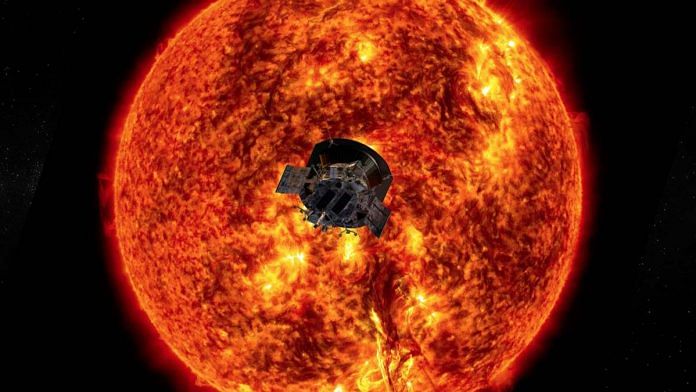New Delhi: NASA’s robotic spacecraft, Parker Solar Probe — which is the closest-ever spacecraft to Sun — has beamed back data from unexplored regions of the solar atmosphere, revealing details that could help better understand how plasma outflows from the Sun affect space weather around Earth.
Parker Solar Probe was launched into space in August last year. The Probe has completed three of the 24 planned passes through unexplored parts of the Sun’s atmosphere, called the corona.
Four new papers in Nature journal published Thursday described what scientists have learnt from this mission.
The findings on how the Sun constantly ejects material and energy will not only help scientists better understand and predict space weather around Earth, but also know the process through which stars are created and how they evolve.
Most of the materials that escape the Sun is part of the solar wind — these materials are continual outflow of solar material that bathes the entire solar system.
This ionised gas, called plasma, carries with it the Sun’s magnetic field, stretching it out through the solar system in a giant bubble that spans more than 10 billion miles.
Also read: North India’s toxic air: NASA images show just how big the stubble burning problem is
Sun’s magnetic field flipped
Near the Earth, the solar wind appears to be in a relatively uniform flow of plasma, with occasional turbulence. However, closer to the solar wind’s source — about 15 million miles from the Sun — the Probe saw a complicated, active system.
“The complexity was mind-blowing when we first started looking at the data,” said Stuart Bale from the University of California, Berkeley, who is heading the Parker Solar Probe’s ‘FIELDS instrument’ section. This section studies the scale and shape of electric and magnetic fields.
Measurements showed quick reversals in the magnetic field of Sun and sudden, faster-moving jets of material.
The scientists also saw flips in the direction of the magnetic field, which flows out from the Sun, embedded in the solar wind. These reversals — dubbed “switchbacks” — last anywhere between a few seconds and several minutes as they flow over Parker Solar Probe.
During a switchback, the magnetic field whips back on itself until it is pointed almost directly back at the Sun.
The exact source of the switchbacks isn’t yet understood, but Parker Solar Probe’s measurements have allowed scientists to narrow down the possibilities, NASA said in a statement issued Thursday.
Also read: Aided by Indian techie, NASA finds crashed Vikram lander on the Moon
Rotation of solar wind
Near the Earth, the solar wind is seen streaming directly from the Sun, straight out in all directions. However, closer to the surface of the Sun, the solar wind spins. This is because the Sun rotates as it releases the solar wind.
According to the findings, for the first time, Parker Solar Probe was able to observe the solar wind while it was still rotating.
Its solar wind instrument detected rotation starting more than 20 million miles from the Sun, and as the Probe approached its perihelion point (point in the orbit of a planet, asteroid or comet that is nearest to the Sun), the speed of the rotation increased.
The strength of the solar wind circulation was more than many scientists had predicted earlier and it also transitioned to an outward flow more quickly than predicted.
“While we hoped to eventually see rotational motion closer to the Sun, the high speeds we are seeing in these first encounters is nearly ten times larger than predicted by the standard models,” said Justin Kasper from the University of Michiganone, one of the scientists involved in the mission.
Dust near Sun
Scientists have long suspected that dust particles, which are ubiquitous in the cosmos, would be heated to high temperatures by powerful sunlight, turning it into a gas and creating a dust-free region around the Sun. However, there was no way to observe this phenomenon.
Parker Solar Probe’s images show that the cosmic dust begin to thin out. The images show dust starting to thin a little over seven million miles from the Sun, and this decrease in dust continues steadily to over 4 million miles from the Sun.
At the rate of thinning, scientists expect to see a truly dust-free zone starting a little more than 2-3 million miles from the Sun, meaning Parker Solar Probe could observe the dust-free zone as early as 2020, when its sixth flyby of the Sun will carry it closer to the surface of the Sun than ever before.
The Probe also provided unprecedented detail on structures in the corona and solar wind — including coronal mass ejections, billion-tonne clouds of solar material that the Sun sends hurtling out into the solar system.
“Since Parker Solar Probe was matching the Sun’s rotation, we could watch the outflow of material for days and see the evolution of structures,” said Russ Howard from the US Naval Research Laboratory, another scientist who was part of the mission.
As Parker Solar Probe continues on its journey, it will make 21 more approaches to the Sun at progressively closer distances, culminating in three orbits which are merely 3.83 million miles from the solar surface.
Also read: World’s most-isolated city catches NASA’s attention as it hunts for innovative tech
(Edited by Debalina Dey)






